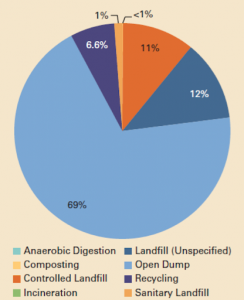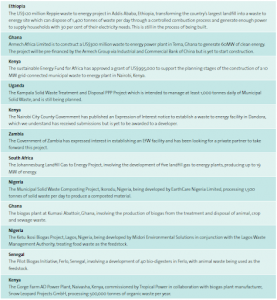With the collaboration of Dr Jean Marc Ndombo
For the methanisation process, According to the World Bank, 69 % of waste in Sub-Saharan Africa is dumped, and often burnt, openly. Furthermore an estimate of 24 % of waste is landfilled and only 7% is currently recycled or recovered for energy production (Figure 7) [6]. Hence, real opportunities exist for the Waste to Energy sector in Africa.

Figure 7: Waste treatment and disposal in Sub-Saharan Africa [6].
Several countries in Africa are seizing such opportunities by developing new waste to energy facilities in order to expand local capacity and meet the growing quantities of waste in the list below [9].

- The methanisation process
Methanisation is a biological phenomenon of transformation of the organic matter by micro-organisms (bacteria) in the absence of oxygen (digestion or anaerobic digestion). It is used to destroy the biodegradable fraction, that is like- ly to pollute[3, 4].
The methanisation produces biogas, which is a renewa- ble energy, and digestor’s sludge (solid phase), which after dehydration and a maturation by composting, forms an organic soil conditioner with the characteristics close to those of the compost: it is a stable produc[5].

More : https://www.afrikatech.com/energy/the-waste-treatment-process/
Other : https://agritrop.cirad.fr/585827/1/RUAF-UAM%2032_WEB-1_11-17.pdf

Leave a Reply